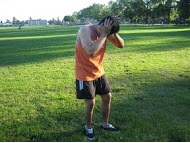Earwax is a recycling center. Most of the time, your ears produce just enough protective wax to trap dust in your ear canal and move it to the ear opening. Then the wax and dust are bathed away whenever you wash around your ears.
But sometimes the wax gets all jammed up-which is uncomfortable, annoying and sometimes downright itchy. Wax can also completely block the ear canal producing a noticeable hearing loss.
If your wax shortage causes itching, augment this treatment with an over-the-counter itch reliever such as hydrocortisone cream. Apply a cream to the outer ear and the itching should ease in a few days.

Dealing with Earwax
So if you find yourself with too much wax, here’s how to deal with it.
- Irrigate earwax. Gently irrigate your ear with body-temperature water. To do it right, you’ll need a syringe and a sinkful of water. Hold your head over the sink while you very gently squirt the water into your ear, letting water and wax run out into sink. Be sure to dry the ear canal after washing.
- Baby your ears. If the wax refuses to budge, you may to soften it up before you irrigate. One way is to use baby oil. Warm up the oil to body temperature, then place a few drops into the ear twice a day.
- Try peroxide. This is another softening method. Fill the ear with a dropper full of peroxide, and let it bubble and work for five minutes or so.
- Clear your canals with nonprescription treatments. Many over-the-counter earwax treatments, such as Murine and Debrox, are actually lubricant-based peroxide solution. It relieves dry skin in the ear canal.
- A stool softener might sit well with you. If you have impacted wax, try using Colace, a stool softener found in most drugstores. Use an eyedropper; put a couple of drops of liquid Colace in each ear. Leave it for a few minutes to an hour or two.
- Don’t use a Pik or a poke. No matter how much earwax accumulates in your ears, don’t be tempted to probe for it with paper clips, tweezers or any small object. You’ll push wax farther into your ear, and you might scratch or damage an eardrum. Don’t use a Water Pik-type device-that’s for teeth only. If you’re going to irrigate your ears, use only an ear syringe.
